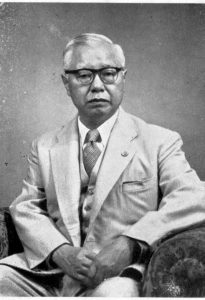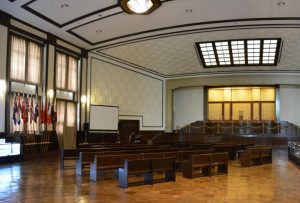Striving to fill voids in Hiroshima, unfinished judgment, Part 1: Tokyo Trial
Apr. 22, 2024
by Kyosuke Mizukawa, Senior Staff Writer
The atomic bombings of Hiroshima and Nagasaki killed countless citizens in the two cities and continued to inflict radiation damage in the survivors after that. The situation was judged to be a violation of international law for the first time in world history in a trial of the atomic bombings, with a ruling passed down in 1963, held at the Tokyo District Court. What was the intention underpinning the ruling, which challenged the positions of both governments of the United States, the nation that dropped the bombs, and Japan? What is the significance of the ruling today? Herein, the Chugoku Shimbun considers the trial by retracing materials and testimonies from people involved.
The Ichigaya Memorial Hall is located in Japan’s Ministry of Defense in Shinjuku, Tokyo. Japan’s defeat in the war 79 years ago deeply informs the hall today, in the area that serves as the core of the country’s national defense.
The hall was constructed in 1937 as a military academy headquarters and contained the offices of Japan’s Army Minister during the war. But the country’s defeat changed everything. The main auditorium inside the building was utilized as a courtroom at the time of the International Military Tribunal for the Far East (also known as the ‘Tokyo Trial’). The victorious Allied nations such as the United States, the United Kingdom, and China sat in judgment of Japan’s wartime leaders.
Attorney Shoichi Okamoto, who died in 1958 at the age of 66, visited the court day after day as a member of the legal defense team. From that court case, Mr. Okamoto had the idea of a trial in judgment of the atomic bombings, an effort for which he later became a proponent.
Keiko Murata, 69, is Mr. Okamoto’s granddaughter who lives in Ashiya City, Hyogo Prefecture. “I believe he must have been frustrated when thinking about why the court ruling was justified without questioning the responsibility for the devastating atomic bombings,” said Ms. Murata, as she ran her hands over her grandfather’s materials still in her possession.
“He considered war to be a crime”
Mr. Okamoto, born in Mie Prefecture in 1891, established a law firm in Osaka when he was 44. His friends deemed him to be “a strong believer in justice” and “a passionate person.” Soon after the end of the war in 1945, he worked on a case of a scandal in which prosecutors in Osaka had pocketed for their own use sugar they had confiscated during an investigation.
In a memoir of his father, Taku Murata, his oldest son who died in 1985, wrote that, “Considering war to be a crime for robbing the precious lives of humans, he despised such conflicts.” Mr. Okamoto joined the defense team at the Tokyo Trial upon request from the attorney, Ichiro Kiyose, who represented the law firm Mr. Okamoto had worked for before opening his own office. During the war, Mr. Kiyose served as a consulting attorney for the Army Ministry.
The Tokyo Trial was held based on the installment regulations for “fair and speedy trials” established by the General Headquarters (GHQ) of the Allied Powers, led by the U.S. military. American attorneys who were familiar with Anglo-American law also joined the trial’s defense team, which was formed of more than 50 lawyers, including Japanese attorneys. One judge from each of the 11 Allied nations was selected to preside over the trial.
The GHQ formed the International Prosecution Section (IPS) for conducting the trial. Twenty-eight Japanese leaders, including former Prime Minister Hideki Tojo, were prosecuted for “crimes against peace” and other offenses. The court sought their responsibility for the former Japanese military’s attack on Pearl Harbor and the mistreatment of prisoners of war, among other charges.
The court was convened on May 3, 1946. On June 4, Joseph Keenan, chief prosecutor for the United States, argued in his opening statement that the trial for Japan’s crimes at that time would contribute to the objective of preventing the scourge of war.
Seeking justice in court
According to his memoir, Mr. Okamoto came up with the idea of questioning the responsibility for the atomic bombings the Allies were willing to overlook while listening to the U.S. lead attorney’s statements. His idea was “the pursuit of responsibility for the atomic bombings from the perspective of the legal profession through solid courtroom and established legal principles.”
If use of an atomic bomb were not considered a crime, such weapons could be used again to achieve victory in wars, which could lead to a series of bombings resulting in the world’s destruction. Mr. Okamoto was looking ahead at the risk to humanity.
Keywords
International Military Tribunal for the Far East (Tokyo Trial)
The Tokyo Trial, held from May 1946 through November 1948 following the conclusion of World War II, involved the prosecution of Japan’s wartime leaders by Allied nations. The defendants were charged with “crimes against peace” for planning, preparing for, and executing a war of aggression, as well as “conventional war crimes” related to violation of international law involving the treatment of prisoners-of-war. Of the 28 leaders on trial, 25 were found guilty, excluding three who had died during the process of the trial. Seven of the defendants were hanged.
(Originally published on April 22, 2024)
The atomic bombings of Hiroshima and Nagasaki killed countless citizens in the two cities and continued to inflict radiation damage in the survivors after that. The situation was judged to be a violation of international law for the first time in world history in a trial of the atomic bombings, with a ruling passed down in 1963, held at the Tokyo District Court. What was the intention underpinning the ruling, which challenged the positions of both governments of the United States, the nation that dropped the bombs, and Japan? What is the significance of the ruling today? Herein, the Chugoku Shimbun considers the trial by retracing materials and testimonies from people involved.
Japanese attorney angered at impunity for A-bombings
The Ichigaya Memorial Hall is located in Japan’s Ministry of Defense in Shinjuku, Tokyo. Japan’s defeat in the war 79 years ago deeply informs the hall today, in the area that serves as the core of the country’s national defense.
The hall was constructed in 1937 as a military academy headquarters and contained the offices of Japan’s Army Minister during the war. But the country’s defeat changed everything. The main auditorium inside the building was utilized as a courtroom at the time of the International Military Tribunal for the Far East (also known as the ‘Tokyo Trial’). The victorious Allied nations such as the United States, the United Kingdom, and China sat in judgment of Japan’s wartime leaders.
Attorney Shoichi Okamoto, who died in 1958 at the age of 66, visited the court day after day as a member of the legal defense team. From that court case, Mr. Okamoto had the idea of a trial in judgment of the atomic bombings, an effort for which he later became a proponent.
Keiko Murata, 69, is Mr. Okamoto’s granddaughter who lives in Ashiya City, Hyogo Prefecture. “I believe he must have been frustrated when thinking about why the court ruling was justified without questioning the responsibility for the devastating atomic bombings,” said Ms. Murata, as she ran her hands over her grandfather’s materials still in her possession.
“He considered war to be a crime”
Mr. Okamoto, born in Mie Prefecture in 1891, established a law firm in Osaka when he was 44. His friends deemed him to be “a strong believer in justice” and “a passionate person.” Soon after the end of the war in 1945, he worked on a case of a scandal in which prosecutors in Osaka had pocketed for their own use sugar they had confiscated during an investigation.
In a memoir of his father, Taku Murata, his oldest son who died in 1985, wrote that, “Considering war to be a crime for robbing the precious lives of humans, he despised such conflicts.” Mr. Okamoto joined the defense team at the Tokyo Trial upon request from the attorney, Ichiro Kiyose, who represented the law firm Mr. Okamoto had worked for before opening his own office. During the war, Mr. Kiyose served as a consulting attorney for the Army Ministry.
The Tokyo Trial was held based on the installment regulations for “fair and speedy trials” established by the General Headquarters (GHQ) of the Allied Powers, led by the U.S. military. American attorneys who were familiar with Anglo-American law also joined the trial’s defense team, which was formed of more than 50 lawyers, including Japanese attorneys. One judge from each of the 11 Allied nations was selected to preside over the trial.
The GHQ formed the International Prosecution Section (IPS) for conducting the trial. Twenty-eight Japanese leaders, including former Prime Minister Hideki Tojo, were prosecuted for “crimes against peace” and other offenses. The court sought their responsibility for the former Japanese military’s attack on Pearl Harbor and the mistreatment of prisoners of war, among other charges.
The court was convened on May 3, 1946. On June 4, Joseph Keenan, chief prosecutor for the United States, argued in his opening statement that the trial for Japan’s crimes at that time would contribute to the objective of preventing the scourge of war.
Seeking justice in court
According to his memoir, Mr. Okamoto came up with the idea of questioning the responsibility for the atomic bombings the Allies were willing to overlook while listening to the U.S. lead attorney’s statements. His idea was “the pursuit of responsibility for the atomic bombings from the perspective of the legal profession through solid courtroom and established legal principles.”
If use of an atomic bomb were not considered a crime, such weapons could be used again to achieve victory in wars, which could lead to a series of bombings resulting in the world’s destruction. Mr. Okamoto was looking ahead at the risk to humanity.
Keywords
International Military Tribunal for the Far East (Tokyo Trial)
The Tokyo Trial, held from May 1946 through November 1948 following the conclusion of World War II, involved the prosecution of Japan’s wartime leaders by Allied nations. The defendants were charged with “crimes against peace” for planning, preparing for, and executing a war of aggression, as well as “conventional war crimes” related to violation of international law involving the treatment of prisoners-of-war. Of the 28 leaders on trial, 25 were found guilty, excluding three who had died during the process of the trial. Seven of the defendants were hanged.
(Originally published on April 22, 2024)









